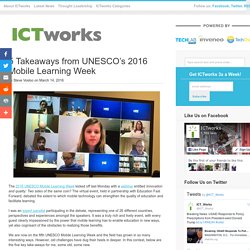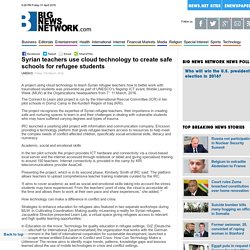

Principle 1: Design with the User. Too often in the field of international development technology tools are created, or tech-enabled projects are designed, without sufficient input from the stakeholders whose engagement and ownership are critical to long-term success.

Principle #1: Design with the User provides recommendations to avoid this common pitfall.Read more community insights > Develop context appropriate solutions informed by user needs.Include all user groups in planning, development, implementation and assessment.Develop projects in an incremental and iterative manner.Design solutions that learn from and enhance existing workflows and plan for organizational adaptation.Ensure solutions are sensitive to, and useful for, the most marginalized populations: women, children, those with disabilities, and those affected by conflict and disaster.
View all. The 2016 UNESCO Mobile Learning Week kicked off last Monday with a webinar entitled Innovation and quality: Two sides of the same coin?

The virtual event, held in partnership with Education Fast Forward, debated the extent to which mobile technology can strengthen the quality of education and facilitate learning. I was an expert panelist participating in the debate, representing one of 26 different countries, perspectives and experiences amongst the speakers. It was a truly rich and lively event, with every guest clearly impassioned by the power that mobile learning has to enable education in new ways, yet also cognisant of the obstacles to realizing those benefits. We are now on the fifth UNESCO Mobile Learning Week and the field has grown in so many interesting ways. However, old challenges have dug their heels in deeper. Syrian teachers use cloud technology to create safe schools for refugee students. FacebookTweetEmailShareThis UNESCO Friday 11th March, 2016 A project using cloud technology to teach Syrian refugee teachers how to better work with traumatised students was presented as part of UNESCO's flagship ICT event, Mobile Learning Week (MLW) at the Organizations headquarters from 7 ' 11 March, 2016.

The Connect to Learn pilot project is run by the International Rescue Committee (ICR) in ten pilot schools in Domiz Camp in the Kurdish Region of Iraq (KRI). The project recognizes the expertise of Syrian refugee teachers, their importance in creating safe and nurturing spaces to learn in and their challenges in dealing with vulnerable students who may have suffered varying degrees and types of trauma. Academic, social and emotional skills In the ten pilot schools the project provides ICT hardware and connectivity via a cloud-based local server and the internet accessed through notebook or tablet and giving specialised training to around 150 teachers. Share this story reader comments. Mobile Learning Publications.
UNESCO Mobile Learning Publications Today there are over six billion mobile phone subscriptions worldwide, and for every one person who accesses the internet from a computer two do so from a mobile device.

Given the ubiquity and rapidly expanding functionality of mobile technologies, UNESCO is enthusiastic about their potential to improve and facilitate learning, particularly in communities where educational opportunities are scarce. This Working Paper Series scans the globe to illuminate the ways in which mobile technologies can be used to support the United Nations Education for All Goals; respond to the challenges of particular educational contexts; supplement and enrich formal schooling; and make learning more accessible, equitable, personalized and flexible for students everywhere. UNESCO Policy Guidelines for Mobile Learning Illustrative Initiatives and Policy Implications. Mobile Learning Publications. Monegraph. TPRC. A Portrait of Smartphone Ownership. As smartphones have grown increasingly common in recent years, these devices have taken on a central role in the information lives of a substantial number of Americans.

And yet, those Americans who rely most heavily on their smartphones as a gateway to online services and information are often the ones whose connections to their devices are most tenuous. This chapter of the report examines the general state of smartphone ownership in America today, with a focus on how these devices fit into the digital access options available to their owners. 64% of Americans now own a smartphone, up from 58% in early 2014 Nearly two-thirds of American adults (64%) now own a smartphone of some kind, up from 58% in early 2014. Smartphone ownership has increased by 29 percentage points since Pew Research conducted its first survey of smartphone ownership in the spring of 2011, when 35% of Americans were smartphone owners.
The Importance Of Learning Objects In Instructional Design For eLearning. The Importance Of Learning Objects: What eLearning Professionals Need To Know A learning object is defined as "a collection of content items, practice items, and assessment items that are combined based on a single learning objective" [3]. Although the term originates from “object-oriented” programming, its use is completely different in eLearning, and has definitely nothing to do with programming languages and code [2]. eLearning professionals should think of learning objects as small sharable “knowledge packages” that include all related learning material needed to cover a specific learning objective of the eLearning course.
The greatest benefit of working with learning objects is, without any doubt, reusability. Technically speaking, thinking of learning objects as SCORM files seems to be a good practice.